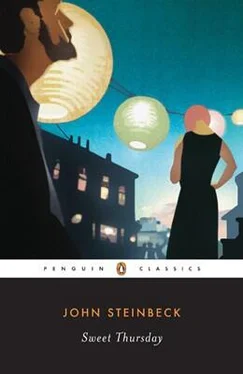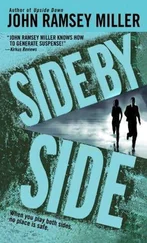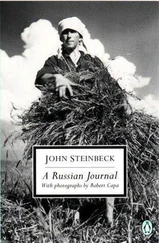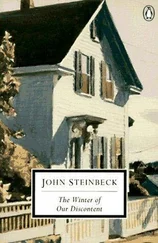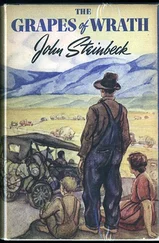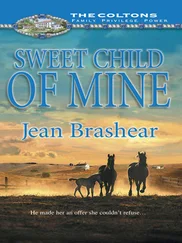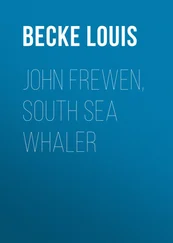John Steinbeck - Sweet Thursday
Здесь есть возможность читать онлайн «John Steinbeck - Sweet Thursday» весь текст электронной книги совершенно бесплатно (целиком полную версию без сокращений). В некоторых случаях можно слушать аудио, скачать через торрент в формате fb2 и присутствует краткое содержание. Год выпуска: 2008, ISBN: 2008, Издательство: Penguin Classics, Жанр: Классическая проза, на английском языке. Описание произведения, (предисловие) а так же отзывы посетителей доступны на портале библиотеки ЛибКат.
- Название:Sweet Thursday
- Автор:
- Издательство:Penguin Classics
- Жанр:
- Год:2008
- ISBN:1-4362-4126-X
- Рейтинг книги:5 / 5. Голосов: 1
-
Избранное:Добавить в избранное
- Отзывы:
-
Ваша оценка:
- 100
- 1
- 2
- 3
- 4
- 5
Sweet Thursday: краткое содержание, описание и аннотация
Предлагаем к чтению аннотацию, описание, краткое содержание или предисловие (зависит от того, что написал сам автор книги «Sweet Thursday»). Если вы не нашли необходимую информацию о книге — напишите в комментариях, мы постараемся отыскать её.
Cannery Row
Sweet Thursday — читать онлайн бесплатно полную книгу (весь текст) целиком
Ниже представлен текст книги, разбитый по страницам. Система сохранения места последней прочитанной страницы, позволяет с удобством читать онлайн бесплатно книгу «Sweet Thursday», без необходимости каждый раз заново искать на чём Вы остановились. Поставьте закладку, и сможете в любой момент перейти на страницу, на которой закончили чтение.
Интервал:
Закладка:
8
Old Jingleballicks: Eccentric Old Jay’s prototype has never been positively identified by scholars, though it is possible he was in some way connected with Stanford’s Hopkins Marine Station, perhaps its onetime director W. K. Fisher, who was initially critical of the quality and nature of Ricketts’s scientific work. In “About Ed Ricketts” (1951), Steinbeck says only that Ricketts “hated one professor whom he referred to as ‘old jingleballicks.’ It never developed why he hated ‘old jingleballicks’ ” (p. xviii).
9
Western Biological Laboratories: Doc’s business was modeled on Edward F. Ricketts’s Pacific Biological Laboratories, cofounded in 1923 in Pacific Grove with Albert Galigher (his former University of Chicago roommate). In the late 1920s, Ricketts, by then the lab’s sole owner, moved the business to 740 Ocean View Avenue in Monterey. Later, the street was renumbered, then renamed, with Ricketts’s lab becoming 800 Cannery Row. The building, now a private social club, still stands. Recently it received a California Governor’s Historic Preservation Award.
10
our victory: Victories by Allied forces over Germany and Japan that ended World War II took place in May and August 1945.
11
Palace Flop house: A shed, once owned by Horace Abbeville and used to store fish meal, that figures prominently in Cannery Row (1945). The Palace Flop house was deeded to Chinese merchant Lee Chong as payment for a grocery debt.
12
“Rock of Ages…St. James Infirmary”: “Rock of Ages” (1776) written by Augustus M. Toplady; “Asleep in the Deep” (1897) written by Arthur J. Lamb, with melody by Henry W. Petrie; “St. James Infirmary,” a folk song of indeterminate authorship, was recorded by many artists, including Louis Armstrong in 1928.
13
Bear Flag: The Bear Flag, so named because it featured a grizzly bear (once native to California), was raised at Sonoma, California, on June 14, 1846, by a group of American settlers led by Captain John C. Frémont in a revolt against Mexican rule. In 1911 California’s state legislature adopted it as the state flag.
14
G.I. bill: The popular name for the Serviceman’s Readjustment Act (1944), which provided college or vocational education for returning World War II veterans.
15
Fort Ord: Originally called Camp Gigling when it was established in 1917, the Fort Ord Military Reservation (1940–94) was located on the Monterey Bay Peninsula between Marina and Sand City. At more than twenty-seven thousand acres, it was one of the largest U.S. Army bases on the West Coast and housed as many as fifty thousand troops. After World War II it became a facility for basic combat and advanced infantry training. Part of the base is now the site of California State University, Monterey Bay.
16
Point Pinos: Located at the northern end of the Monterey Peninsula, Point Pinos was named by Spanish explorer Sebastián Vizcaíno in 1602. It became the site of the oldest continuously operating lighthouse on the West Coast (established in 1855).
17
egg-heady: Highly academic, intellectual, or studious.
18
pachucos: Members of Mexican-American youth gangs in the southwestern United States from the 1930s to the 1950s. The pachuco style and culture originated in El Paso, Texas, but moved quickly westward and became especially prominent in East Los Angeles. Pachucos sported loose-fitting “zoot suits” (oversized trousers and jacket, with a characteristic broad felt hat), which presented an exaggerated version of gangster clothing of the 1930s. Pachucos spoke a unique dialect called Calo, a hybrid blend of formal Spanish with English and Gypsy words.
19
lagged with loaded pennies: Joseph and Mary may have used illegally weighted pennies for the coin toss that determined who would be first to break (“lag”) at pool.
20
badger game…Spanish treasure: Illegal or unethical confidence games. The badger game, for instance, is a dishonest trick in which a person is lured into a compromising situation and then blackmailed.
21
François Villon: French poet, thief, and general vagabond (ca. 1431–ca. 1474).
22
muggles: A slang term for marijuana.
23
wetback: Derogatory name applied to undocumented Mexican immigrants in the United States. The term is thought originally to refer to people crossing the border by swimming across the Rio Grande. Generally, Steinbeck’s use of racially charged terms such as “Chink” and “spick” reflects the attitudes and habits of his characters, not necessarily of the author. His attitude toward Mexican nationals—if not exactly fully realistic or authentic—is nonetheless generally positive and respectful, especially when it is noted that Sweet Thursday appeared during the same year the United States government’s Immigration and Naturalization Service launched Operation Wetback (1954), which targeted illegal Mexican nationals in the southwestern United States and eventually succeeded in deporting eighty thousand of them.
24
Espaldas Mojadas: Joseph and Mary’s group is Wetbacks.
25
“Ven a Mi…que Llora”: Spanish song titles: “Come to Me, My Sorrowful Girl,” “Woman from San Luis,” and “The Little White Cloud That Cries.”
26
charro: The Spanish word for the colorful, even gaudy, traditional outfit of the Mexican cowboy.
27
I. O. O. F.: In de pen dent Order of Odd Fellows, a fraternal organization devoted to improving and elevating the condition of humanity through friendship, love, and truth. Derived from seventeenth-century British orders, the first American I.O.O.F. lodge was chartered in Baltimore, Mary land, in 1819. In 1851, membership was extended to women.
28
Velella: Velella velella, commonly known as By-the-Wind Sailor or Purple Sail, is a jellyfish that resembles a miniature Portuguese mano’-war. Usually blue in color, these jellyfish travel by means of a small stiff sail that catches the wind. They can become stranded on beaches by the millions.
29
Sistine Choir: Recordings of the Vatican’s Sistine Chapel Choir.
30
William Byrd: William Byrd (1540?–1623) was one of the most celebrated English composers of the Renaissance. His three famous masses (in Latin) were written between 1592 and 1595.
31
Faust of Goethe: German author Johann Wolfgang von Goethe’s tragedy of a man who sells his soul to Mephistopheles the devil in exchange for unlimited power. Part I was published in 1808 and revised in 1828–29; part II was published in 1832, the year Goethe died.
32
Art of the Fugue of J. S. Bach: Johann Sebastian Bach (1685 O.S.–1750 N.S.) was a prolific German composer and organist of sacred and secular works for choir, orchestra, and solo instruments. His final (and unfinished) collection of fugues and canons was composed between 1745 and 1750, and published after his death in 1750. See below pp. 80, 135, and 201.
33
Diamond Jim Brady: James Buchanan Brady (1856–1917), American businessman, financier, and philanthropist of the Gilded Age, whose appetite for food was legendary.
Читать дальшеИнтервал:
Закладка:
Похожие книги на «Sweet Thursday»
Представляем Вашему вниманию похожие книги на «Sweet Thursday» списком для выбора. Мы отобрали схожую по названию и смыслу литературу в надежде предоставить читателям больше вариантов отыскать новые, интересные, ещё непрочитанные произведения.
Обсуждение, отзывы о книге «Sweet Thursday» и просто собственные мнения читателей. Оставьте ваши комментарии, напишите, что Вы думаете о произведении, его смысле или главных героях. Укажите что конкретно понравилось, а что нет, и почему Вы так считаете.
